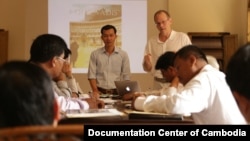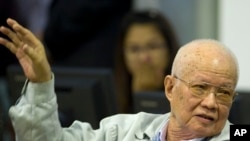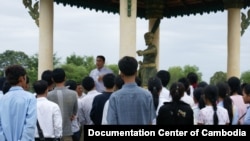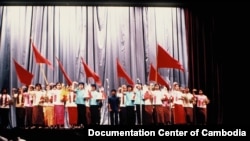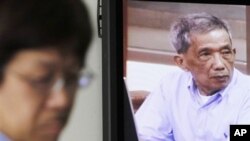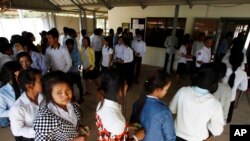[Editor’s Note: Professor Alexander Hinton is the author of “Why Did They Kill? Cambodia in the Shadow of Genocide,” a book published in 2005 on the Khmer Rouge period. In March, he gave evidence at the Extraordinary Chambers in the Courts of Cambodia, otherwise known as the Khmer Rouge Tribunal, in Phnom Penh. The American author and academic took the stand for more than three full court days, giving evidence in case 002/02, which is hearing evidence on genocide charges against top regime leaders Nuon Chea and Khieu Samphan. He spoke with VOA Khmer’s Sayana Ser about his dramatic courtroom confrontation with “Brother Number Two” Nuon Chea, and why—unlike other Western witnesses to the court—he chose to take a traditional Buddhist oath in front of the Lokta Dambang Dek, or lord of the iron staff, Neak Ta at the court. This interview has been edited for brevity and clarity.]
What were you thinking on your first day giving evidence at the Khmer Rouge Tribunal?
It was a very intense three and a half days of giving testimony. When I first arrived, there was a degree of uncertainty because I was uncertain how the process would go, what I would be asked. But I was very excited as well to contribute to what’s an important process in general and in Cambodia in particular. I know at times the court has come under criticism, but I believe that what the court is doing is extremely important.
What moments stood out for you during those days at the court?
When I gave my testimony, I wanted, of course, to provide expert testimony about whatever questions the prosecution, civil parties and the defense had, and I was hoping along the way that I will be able to tell the story of the village and the region where I did my fieldwork from 1994 to 1995. That’s the village called Banyan village that’s located near Wat Phnom Pros Phnom Srey in Kampong Siem district in Kampong Cham. I lived there for a year from 1994 to 1995. And the book that I eventually wrote, and the research I did, was to try and understand the lived experience of living through the Khmer Rouge regime.
In this area, life was pretty good until 1977 when Southwest [Zone] cadres came in and at that point, as in many part of Cambodia, killings began to dramatically escalate, conditions became much more difficult. So, I hoped, even if I responded to the questions, that I would be able to also provide the sense of the lives and suffering of the people from that region during the testimony. In terms of specific moments for me that was important.
Maybe my most disappointed moment was at the very beginning when I wanted to engage in an in-depth discussion of genocide, the meaning of the term, which often is misunderstood. I very much wanted to talk about this in court. But the court has a certain definition that it uses—the U.N. Genocide Convention—and the defense intervened and said I should restrict my comments. So at the very beginning I was a little frustrated that I was unable to have this discussion, but on the other hand, over the course of three and a half days of intense testimony, I was able, in bits and pieces, to discuss the meaning of genocide and how the genocide perpetrated in Cambodia not only fits the four protective groups in the U.N. Genocide Convention—racial, ethnic, national, religious groups—but potentially can apply to broader grouping such as, for example, ethnic Chinese, who came under assault, possibly class-based attacks, maybe the killing of people in the Eastern Zone. So, as proceedings unfolded, I was able to discuss this.
I think one moment that was stood out in the end was when Mr. Nuon Chea, one of the accused, the second in command of the Khmer Rouge, the Democratic Kampuchea regime, after Pol Pot, came to the courtroom to speak. I was glad, his voice has been missing. I strongly believe that the defense should have a clear voice, they should voice their arguments—be heard. He has been silent. He’s chosen not to speak for quite sometime. And so he came up to the courtroom and I was delighted. So that was one of the moments I very much appreciated.
Nuon Chea reacted strongly to evidence you gave about the use of the word Yuon. What are your thoughts about what happened?
I’m unable to know his heart, only he knows his own heart. I can only hear his words. So that’s the basis upon which I have to make a surmise. He did not apologize. And he offered an explanation as, of course he should do. He should present a defense and it should be heard. The larger context of his coming to speak was a discussion that I’ve been having with the defense teams, who had questioned whether the use of the term Yuon in the context of Khmer Rouge speeches was in fact incitement to hate. I have presented based on my fieldwork and the lived experience of the people in Kampong Siem district, as well as my knowledge of Cambodia, having come here many times over the years and the research I’ve done. I made a strong case that while the word Yuon can be used sometimes in a way that doesn’t connote incitement and hate, very often it can be mobilized and used in any ideological discourses, used by politicians to promote a message of hate.
This message, in the context of Democratic Kampuchea was extreme. It’s everywhere in Communist Party of Kampuchea broadcasts, from the radio to party publications, and it seems clear cut that this was an incitement to genocide. I made that point and I understand that for the defense, this was something they felt they needed to respond to.
Effectively, what happened is Nuon Chea came up. He was in a wheelchair. And he came and he spoke—loudly. He said he’d been told by Pol Pot to use the word [Yuon], but he suggested that it didn’t connote hatred. So, I respected what he said, but I disagree. I was given an opportunity to respond to that and one other question, and I said that what is very important is that we think critically and have a dialogue about to use of terms like this in society. I think the discussion that we had is hopefully one that can be opened up more broadly in Cambodia, and more generally, about what it means to use a word, stereotyping, feelings of anger, and sometimes even hate that are associated with this term. So I was pleased that even if he didn’t agree with me he had raised the issue. But it seems quite clear—as I said in the end as I finished speaking to him—that the use of the word Yuon in the context of Democratic Kampuchea was clearly incitement to genocide against ethnic Vietnamese.
Do you think Nuon Chea’s defense team, led by Victor Koppe, was fair when questioning you, in comparison to Khieu Samphan's defense team?
The defense teams are in a difficult position. There is a mountain of evidence against their clients. They express the view that they don’t feel that their voice is always heard sufficiently. So, I understand that as a defense lawyer, you need to do the best you can to defend the rights of the accused.
Some lawyers take up a strategy of disruption. [The late French lawyer] Jacques Vergès, who was initially representing Khieu Samphan, was one of the pioneers in this way. They would seek to disrupt and question the legitimacy of the entire proceedings. This is a common tactic. This is sort of a legal strategy of disruption. Others stick very much to the rule, to the law, and contest a case that way. So the two defense teams have somewhat different strategies.
I think that Mr. Koppe’s strategy is more disruptive. I think that he tries to maybe shake up the person giving testimony if the testimony is incriminating. And I think the testimony I gave about the destruction of the Chams and ethnic Vietnamese in Region 41 of the Central Zone was incriminating. So, even though he tried to attack my arguments in different ways, that’s exactly what he should have tried to do. I’ll leave it to other to judge if sometimes he was a bit too personal, but again I respect what he’s trying to do and defend his client. And I think he should fulfill his duty to the best of his ability.
The defense team for Khieu Samphan as well. They’ve got to work hard. Even though I was confident about all of my arguments and I think they were born out through the process, and it’s quite clear that, for example, the use of the word Yuon incites hate and that genocide was committed against the Chams. Again, their voice needs to be heard, the rights of their client defended. And they should do this to the best of their ability.
You mentioned Grandma Yuth, or Yeay Yuth, a lot in your testimony. What does she have to do with this genocide case?
During this time, an extermination center was created at Wat Phnom Pros Phnom Srey, which was a famous pagoda in Kampong Cham province and they turned it into a security center where well over 10,000, probably over 12,000, people were executed. So many people were dying here. There were also other killing areas—one by Tuol Veng, for example.
But in 1977, after Kuy Thuon and his associates had been purged and were being purged, the destruction arrived in Kampong Siem. The local cadres, who were thought to be associated with Kuy Thuon and his network, were replaced by the cadres from the Southwest. Grandma Yuth, as many people told me, arrived from the Southwest. She became the head of the district. There is another woman, Rorm, who is the head Krala sub-district commune. And I heard many story about them. One story was that grandmother Yuth had been so fierce that she had even agreed [to], or was thought to have killed her husband to show that she had renounced everything for the party.
I should note that the two of them were linked to different cadres from the Southwest, but in particular, [Case 003 suspect] Ta An was also there. He had taken over and he was her superior. But under Grandma Yuth, a great deal of devastation took place including a number of killings, not just ethnic Chams who perished in large numbers in Kampong Siem district, but also “new people,” students, intellectuals, people from the cities who were thought to have capitalistic or privatist tendencies, counter-revolutionary tendencies. At this time, initially, the Khmer Rouge had thought that perhaps people could sharpen their consciousness, to use their phrase, and purify themselves from what they called “impure elements.” But in late 1976 and especially in 1977, these people began to be more and more suspect, and in Kampong Cham we saw the consequence, which was mass execution.
Grandma Yuth, I mentioned her many time because she figured in the experience of the people in the area—her and other cadres, such as Rorm, were known as fierce. And they were feared. I can’t tell you exactly what took place in Grandma Yuth's office. But I can tell you that for the people living in the area, Rorm and Grandma Yuth were terrifying figures. But you know they also symbolize what was the terrifying time in their life when their fear greatly escalated, life became much harder, people lost loved ones, and massive numbers of people were killed that as a broader process in Cambodia of genocide.
During your testimony you mentioned the Khmer Rouge-era novel Dam Pheng. Can you explain why?
There’s a story about Dam Pheng that appeared in the Khmer Rouge magazine revolutionary youth. There is a version that appeared in 1973, but the story is thought to have served as inspiration, for example, of different performances that took place during the Democratic Kampuchea regime. People have spoken about their memories of witnessing this. I believe Youk Chhang, the head the Documentation Center of Cambodia, is on record as having spoken about this as well.
It’s a legendary story of Khmer youth who came from a poor family in the countryside, went to Phnom Penh to study and eventually he became beholden to the Khmer Rouge message. Their message of class oppression, at the time war was going on next door in Vietnam that also had reverberations in Cambodia. So, the story of Dam Pheng tells about how he began to take up the revolutionary cause to fight against U.S. imperialism, against class oppression. And in this story, he epitomizes the qualities of the ideal revolutionary who has a pure conscientiousness, who constantly fights without hesitation. The story ends—I can’t remember the year, I believe it’s in the late 1960s—and Dam Pheng is arrested, he’s tortured, but throughout the process, he doesn’t succumb. He doesn’t reveal his associates, and then, in the end, after being tortured, he writes a poem in blood on his cell before he dies.
As I said before, this was, apparently, a widely known story and one that was used to help propagate the Khmer Rouge ideological message, but I have spoken to someone who says that Dam Pheng was a real person. The story itself, I believe, was mentioned during the Duch trial [Case 001] and is thought to have been a somewhat legendary character and perhaps, it’s thought, Noun Chea or Pol Pot may have actually written this story that appeared in that magazine. We don’t know. Perhaps Noun Chea will one day provide clarification. I had hoped that he might do so, but we don’t know. But Dam Pheng is a figure that symbolizes much and teaches us much about the mindset of Khmer Rouge.
What does Duch a.k.a. Kang Kek Iew, who was convicted in the court’s first case, have to do with case 002?
Duch gave a great deal of evidence that was incriminating toward the case of Noun Chea because he places Noun Chea directly in control of S-21 after Son Sen went to fight the Vietnamese in mid-to-late 1977. Duch’s previous testimony about this has been attacked by the defense lawyers—and again, they’re doing their job, that’s what they should try to do—but if it stands up as most likely it will, it’s very bad for the case of the Noun Chea defense because it directly links him to a process of violence and killing and torture, crimes against humanity and even war crimes that were taking place at S-21. So Duch is very much a person who I would imagine might come and testify again and offer very incriminating evidence against Noun Chea, someone with whom he interacted a number of times during DK [Democratic Kampuchea].
Why did you take a Buddhist oath at the court?
As an anthropologist and as someone who is a visitor in Cambodia, I wanted to honor and respect the traditions of Cambodia and in the Cambodian part of this court, people pay the respects and swear the oath before the Lokta Dambang Dek Neak Ta, and I thought it’s important to respect the traditions that exist in this country. In fact, I think it might be a good thing if everybody had to swear an oath before the Neak Ta. It is a very strong oath. Maybe people are afraid to swear an oath before the Neak Ta, but I was pleased to be able to do so and I thought of the Neak Ta as I testified and I did my best to uphold the oath I made to him, as well as the oath I made in court.
Do you think U.N. war crimes trials in the future should have civil parties, like the Khmer Rouge Tribunal?
This court is very distinctive in having civil parties represented, having a voice to the people brought in. There’s been in the Duch trial, and even going back to the time before the cases began and pre-trial hearings, there was some discussion about what it means for victims to have a voice and to express that voice in court. Whether, for example, a civil party should be able to stand up and actually ask questions to the accused, or to make pleas on their own behalf.
Because it’s extremely complicated and there are a large number of civil parties, a system emerged where civil parties have lawyers and then their co-lead lawyers. I understand that, on the one hand, in order for the trail to run efficiently, it needs to be structured like this. But, on the other hand, there’s also a problem, because the voice of the victims is pushed back to an extent. When I was in the court room, I glanced over at the civil parties, they were backed by the AV booth, sitting in the room, but they said nothing.
I should note that civil parties do speak at the court. It’s important to recognize and be aware of. They are allowed to tell their stories. Not everyone gets to speak, but some people do speak. But if you compare this trial to, for example, the international criminal tribunals in the former Yugoslavia and Rwanda. Despite the shortcomings, this court has made an effort and made progress in helping to give a voice to people. But I think as well, it’s important in retrospect to look back and think how we might strengthen the voice of victims even more.
Do you think the foreign lawyers at the court are sensitive to the local culture of the victims?
I don’t think it’s possible to generalize. I would hope that all lawyers would respect the traditions of Cambodia, respect Cambodian customs. In Cambodia, though, especially if you don’t speak the language, it becomes more difficult. You don’t really understand what’s taking place around you. Perhaps at all courts that are international hybrid mixed tribunals, there should be, for example, cultural sensitivity training that takes place. I think this might be a good thing for everyone. Maybe this is a lesson from the court that in future courts maybe something like this can be done.
Having said that, I have spoken to many international personnel at the tribunal who are very culturally sensitive and want to act in accordance with local understanding, local beliefs. There are others who maybe do so to a lesser extent. For those, I hope they will struggle and work to improve their performance, but at no place is it possible to have things perfect in this manner, but maybe there’s a lesson to be learnt.




